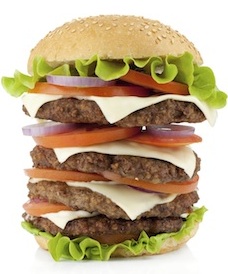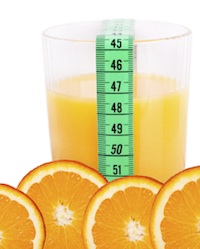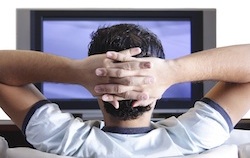- Home
- Blog
- Healthy Weight Loss
- The 13 REAL causes of the obesity crisis
The 13 REAL causes of the obesity crisis
Written by Catherine Saxelby
on Wednesday, 01 October 2014.
Tagged: Calories, junk food, kilojoules, obesity, portion size, soft drinks

Forget SUGAR as the sole villain. Don’t blame FAT alone for the flab. Forget CARBS as the culprit. There is no silver bullet for weight loss and there is no ONE single food or nutrient that can be blamed for our expanding waistlines. Nor ONE single reason for the decline in our physical activity levels. There are many and they’re different for each person who’s carrying excess weight. I’ve unearthed at least 13 possible causes but I’ll wager there are more. So look down my list and tick off which of these 13 (unlucky for some) factors are responsible for your underlying problem.
Obesity is affecting more and more Australians. Latest figures say that 63 per cent of Aussie adults are overweight while 37 per cent are clinically obese (morbidly overweight). There are debates and arguments over what is the precise cause but I really believe you can’t pick just one. Here’s my list of the 13 biggies.
Our ever-increasing input
1. Cheap junk food
Widely available now in vending machines, petrol stations, newsagents and other outlets where food never used to be sold, junk food is deadly due to its triple whammy of fat, sugar and salt. It hits our bliss points as it tastes so darn good that once you start, you can’t stop eating. It’s high in kilojoules/Calories with little fibre or filling power to act as a brake to stop you overdoing it.
2. Huge portion sizes
 It started at fast food joints with their attractive meal deals and buy-one-get-one-free offers which were irresistible. Then it spread to beverages (who needs a huge 600 mL Coke buddy to quench a thirst?) followed by cafés.
It started at fast food joints with their attractive meal deals and buy-one-get-one-free offers which were irresistible. Then it spread to beverages (who needs a huge 600 mL Coke buddy to quench a thirst?) followed by cafés.
I bet you’ve seen the deal - a coffee costs $3.50 while a coffee plus a large muffin costs $4. It’s a bargain that you can’t argue against.
Why not download my free fact sheet - Portion Caution and a PDF as Portion Control?
3. Too much of those fizzy, sweetened drinks
Liquid calories don’t fill you up nor do they register with your brain centre that you’ve had enough. It’s good to see that we’re drinking fewer of them and more bottled water, diet soft drinks and lower-sugar options. Yet despite this, I’ll wager that bottles of the regular, sugar-laden stuff are still taking up the most room in your local take-away fridge.
4. Juice and juice bars
 Healthy, natural and fat-free as fruit is, it’s high in natural fruit sugars (mainly fructose but some sucrose) and these juices come in huge sizes so they can justify their hefty prices of $8 or $10.
Healthy, natural and fat-free as fruit is, it’s high in natural fruit sugars (mainly fructose but some sucrose) and these juices come in huge sizes so they can justify their hefty prices of $8 or $10.
Like all beverages, they are ‘liquid calories’ that we just guzzle.
For more info on juices and their pros and cons take a look at my post The juice trap and download my free PDF fact sheet Juices & juicing for busy bodies.
5. The rise in the home chef
TV shows like Masterchef and My Kitchen Rules not forgetting Jamie, Nigella and Gordon have made expert amateur chefs of us all, but as I’ve pointed out before, ‘chefy’ food choices are not the best for our health. God love them, but they do want to add salt to everything as well as create kilojoule-laden desserts full of cream, sugar and chocolate (and with the latest craze for salted caramel they’re even adding salt to already unhealthy desserts).
6. Growing popularity of pouches and smoothies
First they were convenient for toddlers to suck from. Now they’re carrying adult fruit purées and sauces and creating meals that are all too easy to over consume. Pouches and smoothies condense food and remove the need for chewing which slows our eating down and allows our body to know it’s had enough.
7. Advertising of junk food to children
Much of the overt ads have disappeared thanks to stricter guidelines on advertising to under 12s and a ban on selling soft drinks and confectionery in primary schools. However, a lot of it has gone underground and is subtly woven into games or online competitions where it still gets out and influences young minds. Pester power and school fundraisers are alive and well and still contributing to unhealthy kids.
Our declining output
8. Screen time
 Whether we’re in front of a TV, laptop, iPad or PC or just our mobile phones, it’s still time spent in front of a screen.
Whether we’re in front of a TV, laptop, iPad or PC or just our mobile phones, it’s still time spent in front of a screen.
Increased screen time means less and less activity and makes it more likely that we’ll pile on the kilos. Read more here.
9. Sedentary time
“Beware the chair” is a great slogan to remind us of the dangers of spending too much time sitting and being desk-bound at work. The evidence is mounting to show that prolonged sitting at work, sitting during your commute to work then sitting for leisure increases your risk of diabetes, certain cancers, heart disease and early death.
Australian adults now sit for an average of nearly nine hours a day. That’s longer than the time that most people spend sleeping. While standing all day has its own drawbacks, try to alternate between sitting and standing. Your aim is to sit less, stand up and move more e.g. stand up while on the phone, stand up on public transport, have standing meetings, and choose active ways to hang out with friends (swap the café for a walk).
10. Less active leisure time
Spending free time watching a movie/TV series/playing electronic games or browsing on the computer, with their very low energy expenditure, take up more and more of our leisure hours yet burn off very little of the increasing number of kilojoules we’re ingesting. We need to make it easy easier for people to be healthy via more green spaces (and gardens), housing, and transport. Having access to kitchen gardens means you get to grow healthy food and keep active, get pleasure from growing things in your backyard and be more connected to your neighbours.
11. Lack of sleep
Not getting enough sleep has been linked with being overweight. Why? It seems that when we’re not getting our full quota we seek to overcome fatigue and boost our mental alertness via food and drink of some kind. What’s more, being tired means we lack the energy and motivation for physical activity.
12. Air-con and warmer clothing
We don’t get cold or spend much time shivering any more, thanks to home heating, office heating, overheated retail stores, gas heaters in cafés and the growth in better-engineered outer garments that shield us from the elements. Once sold by camping shops for dedicated hikers and mountaineers, these thermal garments are now easily available to us all so we’re staying warmer and shivering less and burning off less.
Simply being colder raises our metabolic rate (the speed at which kilojoules are burned) by 30 per cent, while shivering itself can burn around 1600 kilojoules /400 Calories an hour as it increases our metabolic rate five-fold.
13. Driving your car
 We still get in our cars and drive everywhere. Yes bicycles are gaining a large following, especially by the young and urban, and where you have regular and frequent trains, ferries and buses - for these people a car is less of a necessity.
We still get in our cars and drive everywhere. Yes bicycles are gaining a large following, especially by the young and urban, and where you have regular and frequent trains, ferries and buses - for these people a car is less of a necessity.
However, in many suburbs there is no alternative, so people have to spend long commutes and school drop-offs in their cars.
As little as two hours a day behind the wheel is a potential risk factor for a range of poor health behaviours and outcomes, a study has shown.
Thanks to student nutritionist Sarah Lutze @ sarahlutze01 for research on the above web links.
More possible causes
A researcher has pointed the finger at the huge increase in the worldwide production and shipping of cheap oil - think of all those fries and doughnuts that need a lot of oil in the manufacture. Vegetable oil, specifically soy bean oil and palm oil, are two of the eight ingredients, alongside wheat, rice, maize, sugar, barley and potato, that are now estimated to provide a staggering 85 per cent of the world's calories. Read more at BBC News.
Save
Save
Foodwatch
The Good Stuff
The Boring Stuff
© 2025 Foodwatch Australia. All rights reserved
Website by Joomstore eCommerce





